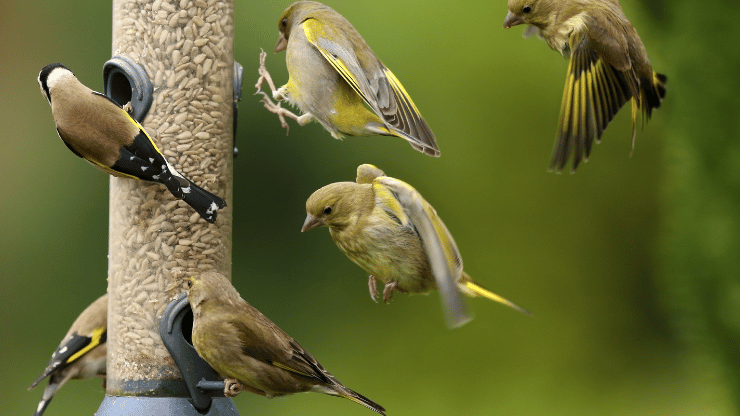Bird feeding is a delightful hobby that brings joy and numerous benefits to both enthusiasts and the birds themselves. Attracting a variety of bird species to your feeder can enhance your backyard’s biodiversity and provide endless entertainment. However, bird enthusiasts often face challenges such as deterring pests, maintaining feeders, and attracting specific bird species.

Choose the Right Feeder
Selecting the appropriate feeder is crucial for attracting the desired bird species. There are several types of feeders, each with its pros and cons:
- Tube Feeders: Ideal for small birds like finches and chickadees. They keep seeds dry and are relatively easy to clean.
- Pros: Versatile, easy to monitor seed levels.
- Cons: Can be difficult to clean, not suitable for larger birds.
- Hopper Feeders: These feeders can accommodate a variety of seed types and attract larger birds.
- Pros: Holds a large amount of seed, attracts a wide range of birds.
- Cons: Can be challenging to clean, more prone to attracting pests.
- Platform Feeders: Perfect for ground-feeding birds such as sparrows and doves.
- Pros: Easy to fill and clean, suitable for many bird species.
- Cons: Seeds are exposed to the elements, more accessible to pests.
Choose a feeder based on the type of birds you wish to attract and the feeder’s ease of maintenance.
Selecting the Best Bird Food
Different bird species have varied dietary preferences, and selecting the right bird food is essential for attracting them:
- Sunflower Seeds: Popular with many bird species due to their high oil content and nutritional value.
- Nyjer Seeds: Favored by finches and small songbirds.
- Suet: Provides essential fats and attracts woodpeckers, nuthatches, and other insect-eating birds.
Always match the food to the bird species you want to attract and ensure the food is kept fresh and uncontaminated to prevent disease.
Optimal Feeder Placement
The placement of your bird feeder significantly impacts its success. Follow these tips for optimal feeder placement:
- Visibility and Safety: Place feeders in locations that are easily visible to birds but not too exposed to predators.
- Distance from Predators: Position feeders away from areas where cats and squirrels can easily reach them.
- Bird-Friendly Environment: Enhance the area around the feeder with trees and shrubs, providing shelter and perching spots for birds.
Maintaining Your Bird Feeder
Regular maintenance is vital to ensure the health and safety of visiting birds:
- Cleaning Schedules: Clean feeders every two weeks to prevent the spread of disease.
- Cleaning Methods: Use a solution of one part bleach to nine parts water to clean feeders thoroughly.
- Pest Prevention: Implement baffles and squirrel-proof feeders to deter pests like squirrels and raccoons.
Attracting Birds Year-Round
Different birds visit feeders during various seasons. Adjust your approach to attract a diverse range of species throughout the year:
- Seasonal Tips: Offer suet in winter for high-energy needs and switch to seeds and fruits in warmer months.
- Adjusting Food and Feeder Placement: Adapt food types and feeder locations based on seasonal bird activity.
- Providing Water and Shelter: Include bird baths or fountains and plant dense shrubs for shelter.
Creating a Bird-Friendly Yard
Transform your yard into a haven for birds by incorporating these elements:
- Native Plants: Plant native flowers, shrubs, and trees to provide natural food sources and habitats.
- Nesting Boxes and Materials: Offer birdhouses and nesting materials to encourage breeding.
- Pesticide-Free Environment: Avoid using chemicals that can harm birds and their food sources.
Troubleshooting Common Issues
Bird feeding can come with its share of challenges. Here’s how to address common problems:
- Feeder Pests: Use squirrel-proof feeders and baffles to keep pests at bay.
- Feeder Crowding: Provide multiple feeders to reduce competition among birds.
- Birds Stopping Visits: Check food quality, cleanliness of feeders, and any changes in the environment that may deter birds.
Engaging in Citizen Science
Participate in birdwatching databases and studies to contribute to scientific research and conservation efforts:
- Bird Counts and Surveys: Join local and national bird counts to help track bird populations and migration patterns.
- Resources for Learning: Utilize online databases and local birdwatching groups for further education and involvement.
Conclusion
bird feeding is a rewarding activity that requires careful selection of feeders, food, and placement, along with regular maintenance. By creating a bird-friendly environment and participating in citizen science, you can enhance your bird feeding experience and contribute to bird conservation. Start or improve your bird feeding setup today and share your tips and experiences in the comments below!
